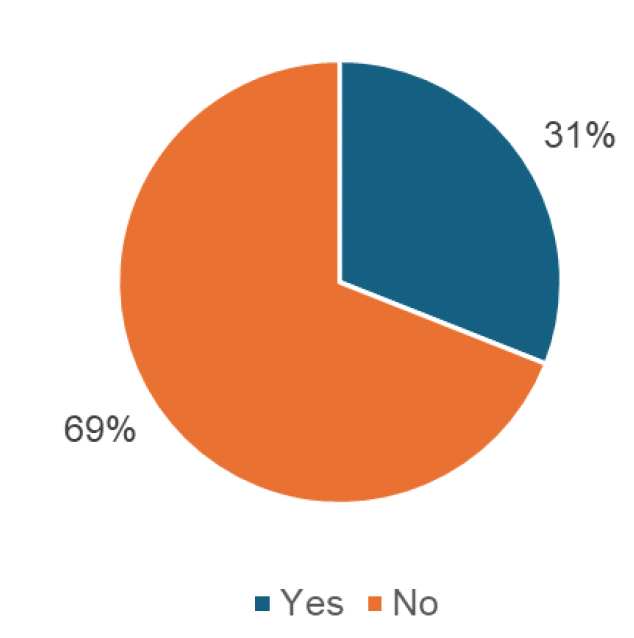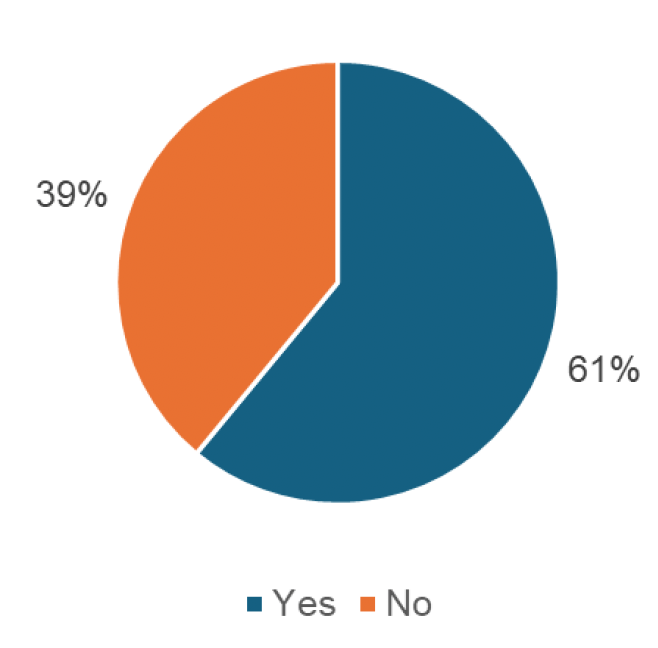Accessible Vehicles and Equipment Scheme evaluation - devolved disability benefits: research
We commissioned The Lines Between (TLB) to carry out research in May 2023 to inform a policy impact evaluation of the Accessible Vehicles and Equipment (AVE) Scheme. This report outlines the findings
4. Awareness and understanding of the Scheme among CDP and ADP clients
Introduction
This chapter discusses awareness of the AVE Scheme among CDP and ADP clients, how clients learned about the Scheme, their understanding of the Scheme and suggestions to enhance awareness further. It draws on evidence from the survey with non-members as well as interviews with members and non-members.
Awareness of the AVE Scheme
Awareness of the AVE Scheme among non-members seems to be low. Of the 580 survey respondents, 69% (398) were unaware of the AVE Scheme.

However, the situation is more nuanced than this data suggests. In follow-up interviews with non-members, it became clear that some (six of 12) who had written in their survey response that they were unfamiliar with the AVE Scheme were, in fact, aware they could lease a vehicle or equipment through Motability but they did not know this was called the AVE Scheme in Scotland. Similarly, members unaware of the AVE Scheme brand thought their Scheme was known as Motability.
“I’m aware of Motability but not AVE.” (Non-member)
“I use Motability and have a car but had no idea this was the new name for it in Scotland.” (Member)
“I thought, well, it's just a change in name. That's the feeling I got from the website, that things remain exactly as they were. It's still Motability, but it has a new name.“ (Non-member)
Our survey findings suggest that recognition of the AVE Scheme is low, but awareness of Motability and of the option to lease a vehicle using disability benefits is likely to be higher than the survey responses indicate.
However, some interviewees told us they did not know they could use their CDP or ADP assistance to lease a vehicle or equipment. In most of these cases, interviewees were aware that support existed to help disabled people access vehicles, but had assumed they were not eligible for that support. Two CDP clients thought they would not qualify because their child is too young to drive. An ADP client felt it would not be relevant for them because they do not drive, another thought it only applied to cars, while a third assumed the Scheme was only for those who needed cars with specialist adaptations. Finally, one assumed the support was only for people more severely disabled than they are. This, along with the quantitative survey responses, demonstrates the scope to raise awareness of the Scheme and who is eligible for it.
“I've just come upon it if I'm honest. I've just found out about it, so I've not really done research on it. That's the reason [I’ve not used it].” (Non-member)
“I had no idea that that qualified me for the Scheme at all. So I never, ever looked into it.” (Non-member)
Sources of awareness
We asked members and non-members how they found out about the AVE Scheme; most became aware of it through information contained with their award letter. Some were informed by third or statutory sector support services, including social workers and health professionals.
Understanding of the Scheme
Those who were aware of the Scheme understood it reasonably well. They knew it involves taking money from their disability benefits to pay for a vehicle or equipment. Often, this understanding is rooted in experience (either their own or that of a friend or family member), awareness or knowledge of the pre-AVE Scheme: Motability is a well-known brand among interviewees.
“I knew of the Motability Scheme because my uncle was on it because he had a stroke.” (Non-member)
However, interviewees were not always aware of all the technicalities and details of how the Scheme works.
“I don't know how it works completely… I don't know, I've got very little basic information about it, and I've not heard much.” (Non-member)
“I didn't know the ins and outs of it or who provided it. I was just aware that it was there.” (Non-member)
As noted above, some misunderstandings and misconceptions were reported to us which indicate a lack of understanding about the Scheme. For example, a small number thought the Scheme only provided cars or was only for older people or those with physical disabilities. A few others thought that people who accessed the Scheme automatically gave up their entire CDP or ADP assistance (not just the mobility component) to pay for the vehicle or equipment, while a belief that the Scheme only provided adapted vehicles, and that the vehicle could only be used by the disabled person, were other misconceptions reported by a small number.
“I didn't look very deep into it, to be fair… but it felt more targeted towards physical disabilities and things like that.” (Non-member)
“I thought it was cars. Because it doesn't make it clear that it's scooters, wheelchairs, aids, this, that. If it was a mobility scooter, that would just be magical.” (Non-member)
“I was more thinking it was for older people. I didn't realise if you had a child that you were eligible.” (Non-member)
There was also uncertainty about who administers the Scheme. As Figure 4.2 shows, 39% of survey respondents aware of the Scheme were unaware Social Security Scotland runs it.

It could be argued that it does not matter whether clients understand the technicalities of the Scheme or who runs it and how it works, but, overall, the responses indicate it would be beneficial to increase understanding of what the Scheme includes and how to access it among non-members. We refer to this issue again in Chapter 7 when discussing lack of awareness of the Scheme as a reason for not using it.
“I think they should make it clear that you can lease these things... And yes, maybe it does affect a little portion of your benefit, but it's not going to be slashed in half. You're not going to be worried about eating or heating.” (Non-member)
“More information about it all would be helpful… how much, how long you got the car for, just those kinds of things.” (Non-member)
Enhancing awareness
CDP and ADP clients receive information about the Scheme with their award letter, this is called a ‘certificate of entitlement’. Interviewees agreed this was an effective way to inform potential members about the Scheme. However, they did not all recall receiving the information and this suggests scope for improvement.
“I think that maybe something should be sent with the award letter that you get to say that you have qualified for this benefit in the same way that they say you know you may now apply for a Blue Badge and you may now apply for other things.” (Non-member)
“I think when they get told they're moving over to Social Security Scotland, they should put a leaflet in with it, saying this is the new scheme here.” (Non-member)
“The only way that I would imagine that would be a suitable way is that those individuals who are eligible to receive the AVE support, to send them material with their certificate of award.” (Non-member)
Participants also put forward other ways to increase awareness of the Scheme. Most commonly, ideas included direct communication from Social Security Scotland (other than award letters) through letters, emails, phone calls or newsletters or including information about the Scheme with the client’s annual review letter.
Other ideas included publishing more prominent information about the Scheme on mygov.scot, Social Security Scotland’s website and social media or using television adverts to raise awareness of the Scheme. A few proposed disseminating information about the Scheme via professionals who work with disabled people, such as healthcare workers and schools attended by CDP clients.
Chapter summary
Our survey data indicates that recognition of the AVE Scheme is low among non-members, but awareness of Motability and of the option to lease a vehicle or equipment using disability benefits is likely higher than the survey responses suggest.
Interviewees displayed a reasonable understanding of the Scheme, but there were some misunderstandings and misconceptions.
Overall, our findings indicate scope to raise awareness of the Scheme, who is eligible for it, what it includes and how to access it.
Ideas for enhancing awareness of the Scheme include communication from Social Security Scotland, online information, television advertising and disseminating information to potential members via professionals who work with disabled people.
Contact
Email: socialresearch@gov.scot
There is a problem
Thanks for your feedback